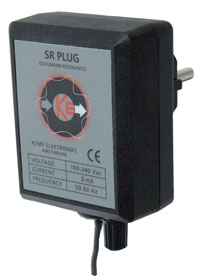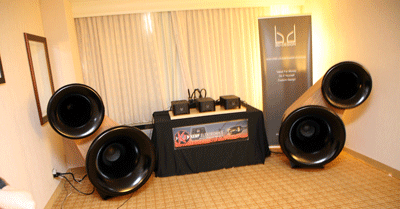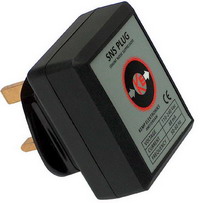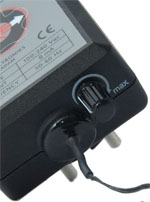Kemp Electroniks Schumann Resonance Plug
| Resonates with me… |
|
|
|
January 2009 |
 In 1952, physicist Winston Otto Schumann mathematically predicted the earth’s electromagnetic resonant frequencies at 7.83, 14, 20, 27 and 33 Hz. There’s plenty information on the Internet about how the human resonant frequency is affected when it is in, or out of, tune with the Schumann resonance. It is argued that our natural resonant balance is in misstep with our beloved planet because of intense radio waves produced by computers, cell phones, microwaves and other types of electromagnetic devices. When perfect balance is restored the effect is peace of mind, body and spirit…and a better sounding audio system. Wikipedia writes, “Interest in Schumann resonances extends beyond the domain of geophysics where it initially began, to the fields of medicine, art and music, and to bioenergetics, acupuncture, and psychobiology. The idea that naturally occurring Schumann resonances, which are many orders of magnitude weaker than both the artificial fields in such studies and typical environmental fields, could yield similar effects is conjectural and highly controversial.”
In 1952, physicist Winston Otto Schumann mathematically predicted the earth’s electromagnetic resonant frequencies at 7.83, 14, 20, 27 and 33 Hz. There’s plenty information on the Internet about how the human resonant frequency is affected when it is in, or out of, tune with the Schumann resonance. It is argued that our natural resonant balance is in misstep with our beloved planet because of intense radio waves produced by computers, cell phones, microwaves and other types of electromagnetic devices. When perfect balance is restored the effect is peace of mind, body and spirit…and a better sounding audio system. Wikipedia writes, “Interest in Schumann resonances extends beyond the domain of geophysics where it initially began, to the fields of medicine, art and music, and to bioenergetics, acupuncture, and psychobiology. The idea that naturally occurring Schumann resonances, which are many orders of magnitude weaker than both the artificial fields in such studies and typical environmental fields, could yield similar effects is conjectural and highly controversial.”
Welcome to controversy!
We’ve written at length about the Acoustic Revive RR-77, which generates the Schumann’s Resonance frequency of 7.83 Hz, to effectively enhance musical enjoyment. This unobtrusive device has certainly bought a lot controversy to our beloved hobby. I have them in-house and can readily attest to their working exactly as advertised. And though I am by nature skeptical of peripheral devices such as these, devices that need only be placed in the listening room and not connected into a stereo system per se, I too heard a more dimensional sound stage and an improved low end that sounded tighter and richer. Call me crazy. I don’t care. Just be sure to mention “happy” too. In fact, I was so taken by the Acoustic Revive’s RR-77’s, thanks to Mike Silverton’s initial review, I tried the Schumann Earth Safe device too (from an entirely different manufacturer) and found – though it is the least attractive – it produced similar sonic improvements. The Earth Safe comes with a frequency adjustment knob, and my suspicion is – since Mike also tried the Earth Safe but with minimal results – that perhaps he didn’t have his dialed in precisely at the recommended 7.83 Hz.
Both the AR RR-77 and Earth Safe are table top devices. But placing one 5-feet high and between one’s loudspeakers – as suggested – in my case was impossible. But I heard results with the units on top of my equipment rack in the left side of my listening space, about 4 1/2 feet off the floor. If the ideal location is between one’s loudspeakers and up 5 feet, how much better would they sound in that location? And why in the world weren’t they designed so you can hang them? David Kaplan, co-designer of the Shakti Hallographs and a serious tweakaholic, has tried the RR-77s in numerous locations in his listening space and also found the center position between his loudspeakers (where there is a fireplace) as the ideal spot. I am not so fortunate in that regard but luck followed me while perusing the Rocky Mountain Audio Fest this past Fall.

Walking the halls of the Audio Fest, I noticed a room that contained my favorite transducers: horns. This particular horn was the odd looking but attractive BD-Design Oris Swing ($32k). Before I sat to listen to this impressive looking rig I passed a table full of small boxes with a small sign that read “noise attenuators.” The designer, Ron Kemp, of Amsterdam, greeted me and quietly allowed me to look over his designs.  Three wall-wart type plugs/modules starting with a Shunt Noise Suppressor plug and a Quantum Approach Plug which all looked familiar to me, having played with each in some form or another. Kemp’s AC conditioners were being used in the room and sounded quite impressive. But what really got me excited was when I happened to glance at the third plug and read in bold print “Schumann Resonance!” My first thought was “Schumann Resonance in this little box? Hmm. Amsterdam…Kemp rhymes with Hemp….Hmm”
Three wall-wart type plugs/modules starting with a Shunt Noise Suppressor plug and a Quantum Approach Plug which all looked familiar to me, having played with each in some form or another. Kemp’s AC conditioners were being used in the room and sounded quite impressive. But what really got me excited was when I happened to glance at the third plug and read in bold print “Schumann Resonance!” My first thought was “Schumann Resonance in this little box? Hmm. Amsterdam…Kemp rhymes with Hemp….Hmm”
When I inquired what the Schumann module did to an acoustic space, Ron Kemp simply stated, soberly I might add, “The SR plug improves the bass, makes the music clearer and more dimensional.” I thought to myself, wow, that’s exactly what the Acoustic Revive did. My next question was a formal request for review since attempting to hear them in a room totally unfamiliar to me would prove pointless. I have spoken to folks that used three and four AR RR-77s in different positions and all agreed the results were improved smoothness, detail and bass definition, not to mention greater sound stage and three-dimensionality. The better questions for me were, could two different devices co-exist, and if so, what would be sonic results be?
 Ron Kemp (photo) is an audiophile and has been manufacturing AC conditioners and related tweaks for over ten years (he currently has over 20 products on the market). He learned about the Schumann Resonance in 2002 and began working on finding a way to implement it in his products. It wasn’t until 2007 that Kemp achieved satisfactory performance and he formally introduced the Schumann Resonance plug the same year.
Ron Kemp (photo) is an audiophile and has been manufacturing AC conditioners and related tweaks for over ten years (he currently has over 20 products on the market). He learned about the Schumann Resonance in 2002 and began working on finding a way to implement it in his products. It wasn’t until 2007 that Kemp achieved satisfactory performance and he formally introduced the Schumann Resonance plug the same year.
My review samples of the SR plugs arrived in about two weeks. Also in the box were three Shunt Noise Suppressors and three Quantum Approach devices. As anxious as Ron Kemp was to have me review all three of his products, the Shunt Noise Suppressors only worked marginally, while I didn’t like the Quantum Approach devices at all. Thus, this review will be of the SR plugs only.
Physically, the Kemp SR plug looks like a small and inexpensive AC power supply that could fit in the palm of your hand. Essentially, the SR plug is a Schumann Resonance oscillator with an eight foot wire that serves as an antenna. It is a totally passive device that you can plug in and out of your electrical circuit without having to turn off your audio system (nice, particularly for A/B comparisons sake).  A rather nice feature is the addition of a small intensity knob. This knob adjusts the strength of the 7.83 Hz signal radiated by the antenna. Retail price is 195 Euros, which would make it about the same price as the RR-77 with the ever weakening US dollar. Based solely on the SR plug’s appearance, I would suggest this price is rather high; it just doesn’t look that expensive to make. However, judged in terms of its effect on sound quality, I think the Kemp SR plug is a bargain. Here’s why.
A rather nice feature is the addition of a small intensity knob. This knob adjusts the strength of the 7.83 Hz signal radiated by the antenna. Retail price is 195 Euros, which would make it about the same price as the RR-77 with the ever weakening US dollar. Based solely on the SR plug’s appearance, I would suggest this price is rather high; it just doesn’t look that expensive to make. However, judged in terms of its effect on sound quality, I think the Kemp SR plug is a bargain. Here’s why.
The sonic benefits of adding the Kemp SR plug(s) into my listening space were immediate and obvious. With the RR-77 still powered up, I could easily hear greater three-dimensionality placing a single Kemp SR plug directly center, between my Sunny loudspeakers. Yes, all the accolades formerly applied to the RR-77s were applicable to the SR plug. A greater sense of air and bloom seemed to surround instruments. The acoustic space of each recording also made itself more apparent making the leap of faith of “being transported to the recording” that much more believable. I finally understood the importance of having a Schumann device centered between my loudspeakers and could easily appreciate its thin wire application.
Listening to the classic CD ofMr. Billy Higgins, featuring a particularly stunning version of the song “John Coltrane,” turned into a real treat with the Kemp SR plug in-house. The song features Gary Bias on woodwinds, and though I’ve listened to this song many times over the years, Bias sounded as though he was blowing with more intensity – with more air – providing his instrument, and this remarkable jazz recording, more life and vibrancy.

Taking Ron Kemp’s advice, I got an el-cheapo power strip and, one at a time, very carefully added a total of four SR plugs into the mix. Working in tandem with four 8-foot long antennas draped over my jazz art located center between my loudspeakers I found their cumulative effects rather startling. I found that increasing the signal strength beyond the 12:00 point (approximately half power) robbed the music of important harmonics and overtones which meant I had to double check the intensity knobs were kept at the mid level mark (Kemp states the intensity knob differs according to room size hence the larger the room the more intensity one may need).
I should point out that I haven’t heard of too much 7.83Hz radiation proving harmful except when situated too close to the listening position (Mike Silverton complained of headaches). In fact, I’ve one directly behind me and have noted no ill effects whatsoever, thus far. That duly noted, having four SR plugs located dead-center between my loudspeakers and two RR-77s located in the extreme corners behind the Sunny Majestic loudspeakers opened up a sound stage so wide and three-dimensional and so utterly natural, I initially didn’t want to mention it for fear no one would believe it. So, instead of telling anyone, I merely invited them over and didn’t say a word. Considering how invisible the SR plugs are, it wasn’t hard at all to keep them hidden. In each case the remarks went from “What did you do this time?” or “Did you move your loudspeakers further apart?” In every case the mention of “unbelievable” dynamics, three-dimensionality and bass articulation was brought up. I am not saying my system didn’t possess these sonic attributes already. What I am saying is the addition of these small invisible tweaks made their strengths even more discernable.
In the end, I can see a lot of doubting Thomases out there saying we’ve all flipped our collective wigs as I include contributors Russell Lichter, Dennis Parham, Moreno Mitchell, Mike Wright and Carlos Sanchez to the list of audiophile advocates. (And of course, Mike Silverton was the first to write positively on the RR-77s mysterious workings). Dave Thomas also had the opportunity to hear the effects of Schumann Resonance and wondered what all the fuss was about; he heard nothing different. (I’ve often wondered if the Windy City operated on a different “resonance curve” because the people there are so, ahem…different). Go figure. Guess that’s what makes the world go ’round and some aspects this hobby so mysterious.
Bottom line, I trust my own ears and the ears of a few trusted friends. They all heard the improvements without coaxing or suggestions. Moreover the sonic results of adding more units proved cumulative, offering more natural texture, bass articulation, sound stage and three-dimensionality. Let me reiterate, increasing the intensity knob on the SR plug beyond a certain point impacts the harmonics and overtones negatively. In my opinion it doesn’t provide the sonic equivalent of adding more SR plugs. The Kemp Elektroniks SR Plug works as well as the RR-77 with one great advantage: they’re almost invisible, which makes them ideal for placement between your loudspeakers. Highly recommended especially if you’re already a fan of the RR-77 or other type Schumann Resonance devices.

![]()
Manufacturer:
KEMP ELEKTRONIKS
Quellijnstraat 15
1072 XM Amsterdam
The Netherlands
Price: $300.00 USA
Tel: +31(0)20-7764464
Fax: +31(0)20-7775446
Mobile: +31(0)6-54691901
Email: info@kempelektroniks.nl
Website:http://www.kempelektroniks.nl
![]()
Don’t forget to bookmark us! (CTRL-SHFT-D)
Stereo Times Masthead
Publisher/Founder
Clement Perry
Editor
Dave Thomas
Senior Editors
Frank Alles, Mike Girardi, Key Kim, Russell Lichter, Terry London, Moreno Mitchell, Paul Szabady, Bill Wells, Mike Wright, Stephen Yan, and Rob Dockery
Current Contributors
David Abramson, Tim Barrall, Dave Allison, Ron Cook, Lewis Dardick, Dan Secula, Don Shaulis, Greg Simmons, Eric Teh, Greg Voth, Richard Willie, Ed Van Winkle, and Rob Dockery
Music Reviewers:
Carlos Sanchez, John Jonczyk, John Sprung and Russell Lichter
Site Management Clement Perry
Ad Designer: Martin Perry





Be the first to comment on: Kemp Electroniks Schumann Resonance Plug